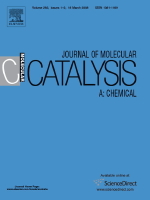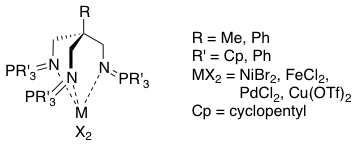"New Tripodal Iminophosphorane-Based Ethylene Oligomerization Catalysts. Part II. Catalytic Behavior"
Laurence Beaufort, Federica Benvenuti, Lionel Delaude, and Alfred F. Noels
 |
source: Journal of Molecular Catalysis A: Chemical
year: 2008
volume: 283
first page: 77
last page: 82
doi: 10.1016/j.molcata.2007.12.012
|

Abstract: Seven transition metal complexes of general formula RC(CH2NPR'3)3)MX2 based on new tripodal iminophosphorane ligands were investigated as initiators for the oligomerization of ethylene in the presence of aluminum co-catalysts using high throughput techniques. In all cases, ethylene consumption peaked at ca. 30 °C and was not drastically affected by varying the nature of the metal (M = Ni, Fe, Pd, Cu), the aluminum co-catalyst (MMAO, Et2AlCl, or EtAlCl2) or the substituents of the tris(iminophosphorane) ligand (R = Me, Ph; R' = cyclopentyl, Ph). Structural modifications of the organometallic complexes, either at the metal center or within the tripodal ligand, however, had a significant impact on the oligomer distribution obtained. In particular, Pd-based catalyst (PhC(CH2NPPh3)3)PdCl2 displayed an excellent selectivity toward hexene formation.
Keywords: Cu Complexes, Fe Complexes, Ni Complexes, Pd Complexes, Tripodal Ligand
[Full Text] [<< Previous Article] [Back to the List of Publications] [Next Article >>] l.delaude@ulg.ac.be